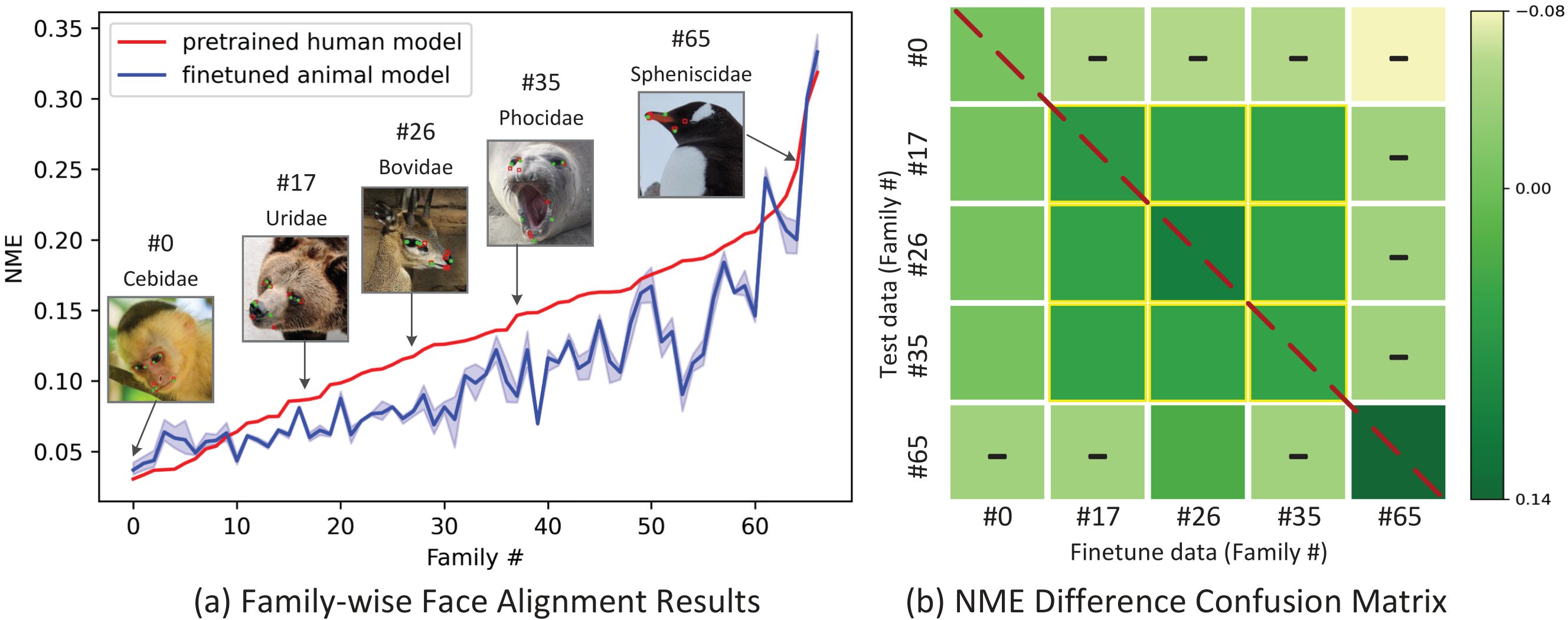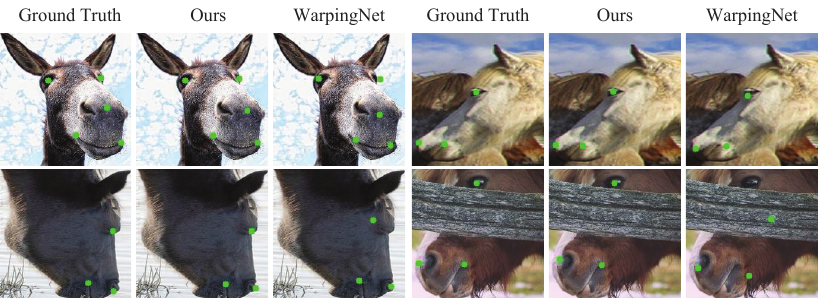This project is the implementation of our proposed method Meta-CSKT [ACMMM23]CSKT.pdf. The supplementary materials of our proposed Meta-cskt are available at: mm23_supp_meta_cskt.pdf
Animal face alignment is challenging due to large intra- and inter-species variations and a scarcity of labeled data. Existing studies circumvent this problem by directly finetuning a human face alignment model or focusing on animal-specific face alignment~(e.g., horse, sheep). In this paper, we propose Cross-Species Knowledge Transfer, Meta-CSKT, for animal face alignment, which consists of a base network and an adaptation network. Two networks continuously complement each other through the bi-directional cross-species knowledge transfer. This is motivated by observing knowledge sharing among animals. Meta-CSKT uses a circuit feedback mechanism to improve the base network with the cognitive differences of the adaptation network between few-shot labeled and large-scale unlabeled data. In addition, we propose a positive example mining method to identify positives, semi-hard positives, and hard negatives in unlabeled data to mitigate the scarcity of labeled data and facilitate Meta-CSKT learning. Experiments show that Meta-CSKT outperforms state-of-the-art methods by a large margin on the horse dataset and Japanese Macaque Species, while achieving comparable results to state-of-the-art methods on large-scale labeled AnimalWeb~(e.g., 18K), using only a few labeled images~(e.g., 40).
(a) Results for AnimalWeb by 1 human and 3 animal models, sorted in ascending order of NME by the human model. We randomly select 40 images from AnimalWeb for finetuning and repeat it 3 times. (b) Confusion matrix of NME difference between human and animal models. The x-axis represents the finetune data used to train the animal model, and y-axis represents the test data used to evaluate the model. We randomly select 40 images from each family as the finetune data. Elements with/without a minus sign indicate decreased/increased accuracy. Darker Green indicates a larger difference.
Horse dataset provided by menorashid.
AnimalWeb dataset could be downloaded through the link AnimalWeb
Japanese Macaque dataset is a subset of AnimalWeb, which only contains Japanese Macaque species.
pytorch 1.7+
python 3.8
We did some experiment on Horse dataset provided by menorashid.
In test_horse_img.ipynb, just run all or you can change the image files.
imgname = [ 'horse/im/flickr-horses/203.jpg',
'horse/im/flickr-horses/2756.jpg',
'horse/im/flickr-horses/6189.jpg',
'horse/im/imagenet_n02374451/n02374451_2809.jpg']
model_name = 'checkpoint_horse/horse.pth.tar' #change it to the model you want to useFirst, unzip the data and it will look like this:
release_data
--aflw
--face
--horse
To run the training code, we can use the following command:
First, change the DATASET.ROOT in experiment/horse.yaml and experiment/horse_test.yaml to the path of release_data:
DATASET:
ROOT: 'path of release_data'Download pretrained horse model and put it in pretrained_model
python train_horse.py --cfg ./experiment/horse.yaml --save-path ./checkpoint_horse --seed 5 --unlabel-root "data root of AnimalWeb" --unlabel-bbox ./data/bbox.csv --name horse --dataset animalweb --lambda-u 8 --student-wait-steps 0 --amp --resume ./pretrained_model/horse_pretrain.pthFirst, change the DATASET.ROOT in experiment/horse.yaml and experiment/horse_test.yaml to the path of release_data:
DATASET:
ROOT: 'your path'Download the trained mode, put it in checkpoint_horse
python test.py --cfg ./experiment/horse_test.yaml --seed 5 --name test_horse --dataset animalweb --evaluate --resume checkpoint_horse/horse.pth.tarDownload the pretrained model, and put it under pretrained_model/
train_ours.py --cfg ./experiment/primate.yaml --update-steps 600 --name japanese_macaque --l-threshold 0.0 --f-threshold 0.2 --human_shift japanese_human.csv --flip_shift japanese_flip.csv --total-steps 10000 --save-path ./checkpoint --seed 5 --dataset animalweb --lambda-u 8 --student-wait-steps 0 --resume ./pretrained_model/japanesemacaque.pth| Model | Link |
|---|---|
| japanesemacaque_best.pth.tar | japanesemacaque_best.pth.tar |
test.py --cfg ./experiment/primate.yaml --seed 5 --name japanese_macaque_test --dataset animalweb --evaluate --resume checkpoint/japanesemacaque_best.pth.tarWe provide the trained model, you could download our model through the link below.
| Model | Link |
|---|---|
| 40img trained | animalweb_40img.tar |
| 80img trained | animalweb_80img.pth.tar |
Download the one you want to test, and put them into checkpoint directory:
checkpoint
----animalweb_40img.tar
----animalweb_80img.pth.tar
test.py
To test the single image, we use test_animalweb_img.ipynb.
In this jupyter notebook, the to test image name and the model to test need to be specified.
imgname = ['arcticfox_37.jpg',
'bull_83.jpg',
'domesticcat_62.jpg',
'pademelon_106.jpg']
model_name = 'checkpoint/animalweb_80img_best.pth.tar' #change it to the model you want to useYou could check the animalweb dataset to choose the image you want to test on your own and just copy the file name.
Once you change the imgname and model_name, you could just run all.
To test the result, you could use command below:
# Test 80 img
# Known Setting
python test.py --cfg ./experiment/test_80_known.yaml --seed 5 --name test_80_known --dataset animalweb --evaluate --resume checkpoint/animalweb_80img.pth.tar
# Unknown Setting
python test.py --cfg ./experiment/test_80_unknown.yaml --seed 5 --name test_80_unknown --dataset animalweb --evaluate --resume checkpoint/animalweb_80img.pth.tar
# Test 40 img
# Known Setting
python test.py --cfg ./experiment/test_40_known.yaml --seed 5 --name test_40_known --dataset animalweb --evaluate --resume checkpoint/animalweb_40img.tar
# Unknown Setting
python test.py --cfg ./experiment/test_40_unknown.yaml --seed 5 --name test_40_unknown --dataset animalweb --evaluate --resume checkpoint/animalweb_40img.tar
For each cfg file, you need to change the dataset directory to your own location:
DATASET:
DATASET: AnimalWeb
ROOT: 'YOUR_OWN_LOC'
TRAINSET: './data/train_80img.txt'
UNLABELSET: './data/all.txt'
VALSET: './data/all_150.txt'
TESTSET: './data/all.txt'
BBOX: './data/bbox.csv'
...| Model | Link |
|---|---|
| Human Pretrained | HR18-AFLW.pth |
| 80img trained | 80img_pretrain.pth |
Download the pretrained model and put them like this:
pretrained
--HR18-AFLW.pth
pretrained_model
--80img_pretrain.pth
train_ours.py
To train this model, use command below:
# Train 80 img model
python train_ours.py --cfg ./experiment/80.yaml --update-steps 600 --name animalweb_80img --l-threshold 0.050 --f-threshold 0.2 --human_shift human_80.csv --flip_shift flip_80.csv --total-steps 10000 --save-path ./checkpoint --seed 5 --dataset animalweb --lambda-u 8 --student-wait-steps 0 --resume ./pretrained_model/80img_pretrain.pth
We conduct the ablation study on AnimalWeb using 40 labeled images.
| Model | Link |
|---|---|
| uda_40img.pth.tar | uda_40img.pth.tar |
# Test 40img known
python test.py --cfg ./experiment/test_40_known.yaml --seed 5 --name test_40_known_uda --dataset animalweb --evaluate --resume checkpoint/uda_40img.pth.tar
# Test 40img Unknown
python test.py --cfg ./experiment/test_40_unknown.yaml --seed 5 --name test_40_unknown_uda --dataset animalweb --evaluate --resume checkpoint/uda_40img.pth.tar| Model | Link |
|---|---|
| fixmatch_40img.pth.tar | fixmatch_40img.pth.tar |
# Test 40img known
python test.py --cfg ./experiment/test_40_known.yaml --seed 5 --name test_40_known_fixmatch --dataset animalweb --evaluate --resume checkpoint/fixmatch_40img.pth.tar
# Test 40img Unknown
python test.py --cfg ./experiment/test_40_unknown.yaml --seed 5 --name test_40_unknown_fixmatch --dataset animalweb --evaluate --resume checkpoint/fixmatch_40img.pth.tarGo to the scarcenet repo (forked from ScarceNet)
If you have any questions, please contact the authors:
Dan Zeng: zengd@sustech.edu.cn or danzeng1990@gmail.com
Shanchun Hong: shanchuhong@gmail.com
Qiaomu Shen: shenqm@sustech.edu.cn





